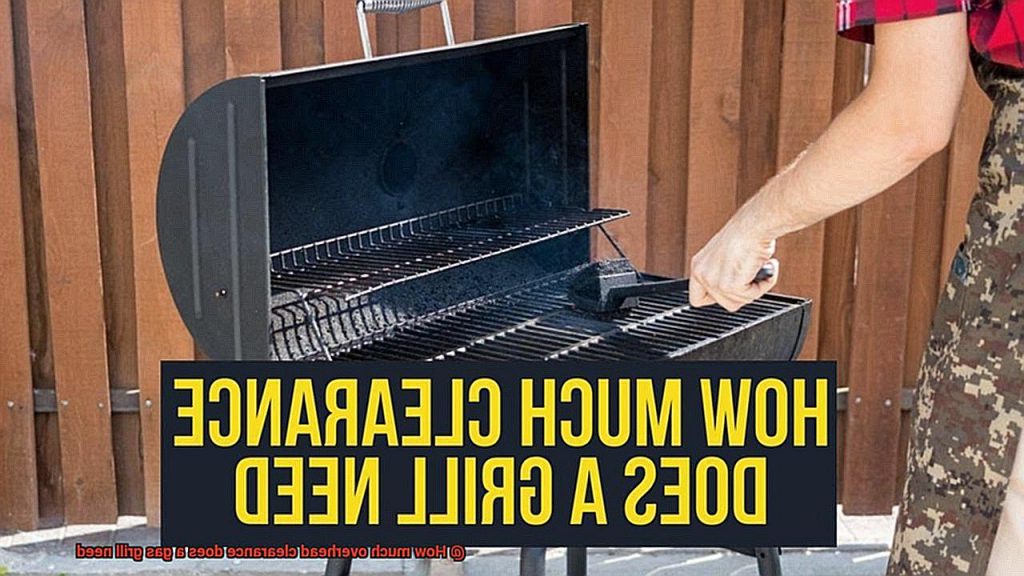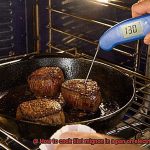So, you’ve got your heart set on a shiny new gas grill for those summer cookouts. But before you get too excited, there’s one crucial factor you need to consider: overhead clearance. Yes, that’s right – the space above your grill matters just as much as what’s sizzling on the grates.
Picture this: You’re all geared up to try out your brand-new grill, but as soon as you light it up, disaster strikes. Smoke and sparks are flying everywhere because your grill is dangerously close to those pesky tree branches hanging overhead. Not exactly the dream backyard BBQ scenario.
To avoid this nightmare and ensure a safe and enjoyable grilling experience, it’s essential to know how much overhead clearance your gas grill needs. But how much is enough? And what other hazards should you be aware of?
Fear not – we’ve got you covered in this blog post. We’ll delve into the nitty-gritty of gas grill overhead clearance and give you the lowdown on recommended distances for different types of grills and locations. Plus, we’ll share some handy tips to keep your setup safe and hassle-free.
So grab yourself a cold one (or two) and settle in – let’s make sure your next backyard BBQ is a roaring success.
Contents
What Is the Minimum Overhead Clearance for a Gas Grill?
When it comes to setting up a gas grill, safety should always be the top priority. One of the most important factors to consider is the amount of overhead clearance needed for safe operation. This refers to the space between the top of the grill and any objects located above it, such as a patio cover or tree branch.
So, what is the minimum recommended overhead clearance for a gas grill? Most manufacturers and safety guidelines suggest a minimum of 24 inches. In other words, there should be at least two feet of space between the top of your grill and any overhead structures or objects. This will prevent any potential fire hazards and ensure that you can enjoy grilling without any worries.
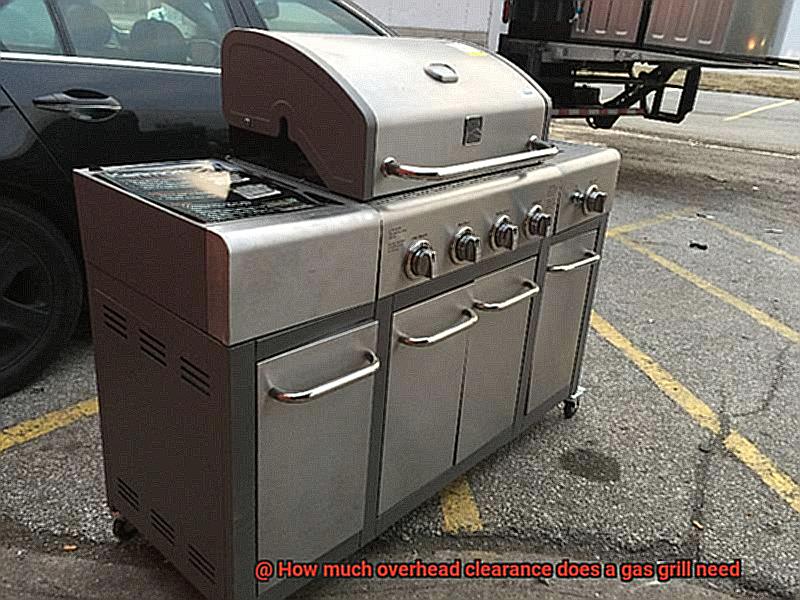
However, keep in mind that this is only the minimum recommendation. Depending on the size of your grill and any specific safety concerns in your area, you may need more space. For instance, if you live in an area prone to high winds or heavy snowfall, you may want to consider increasing the overhead clearance to prevent any potential tipping or damage.
In addition to providing enough overhead clearance, it’s also crucial to ensure that your gas grill is placed on a stable surface. A level concrete or paver patio is an ideal location for a gas grill, while a wooden deck should be structurally sound and able to support the weight of your grill.
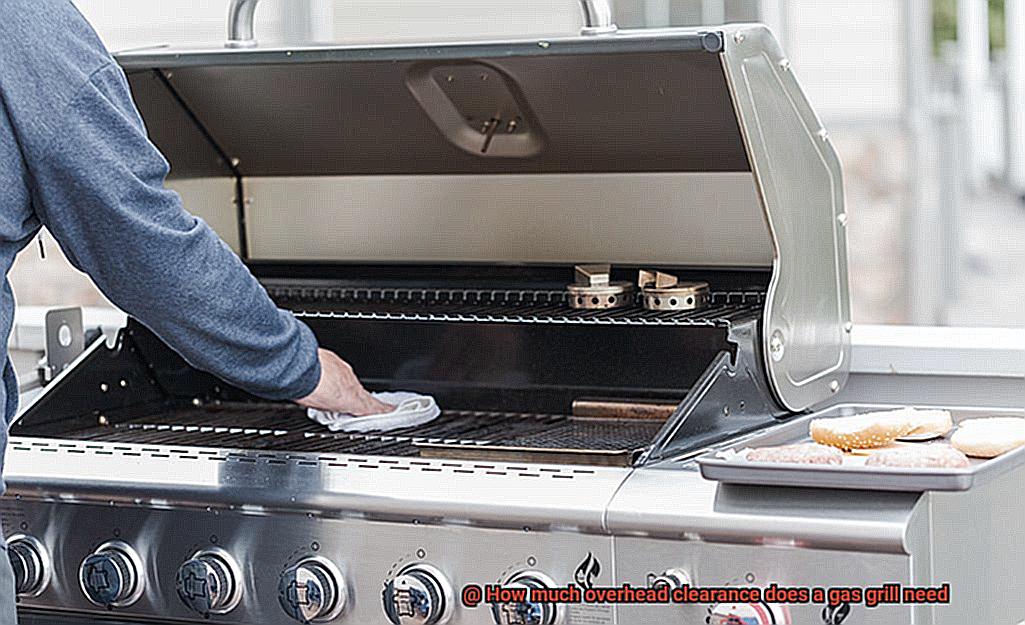
To ensure maximum safety when setting up your gas grill, follow these guidelines:
- Provide at least 24 inches of overhead clearance between the top of your grill and any objects above it.
- Consider increasing the overhead clearance if you live in an area prone to high winds or heavy snowfall.
- Place your grill on a stable surface such as a level concrete or paver patio.
- Ensure that a wooden deck is structurally sound and can support the weight of your grill.
If you’re unsure about how much overhead clearance your gas grill needs, consult the owner’s manual or contact the manufacturer directly. They can provide specific recommendations based on your grill’s size and features.
Factors That Affect the Required Clearance Distance
When it comes to grilling, safety should always be the top priority. Before setting up your gas grill, it’s crucial to determine the required clearance distance. But how do you know what this distance is? Let’s take a closer look at the factors that affect the required clearance distance and how to ensure maximum safety.
Firstly, the type of grill is a significant factor in determining the required clearance distance. A built-in gas grill that’s permanently installed in an outdoor kitchen may require less overhead clearance than a portable gas grill used on a deck or patio. Portable grills may not have the same level of ventilation as built-in grills, which means they need more space to operate safely.
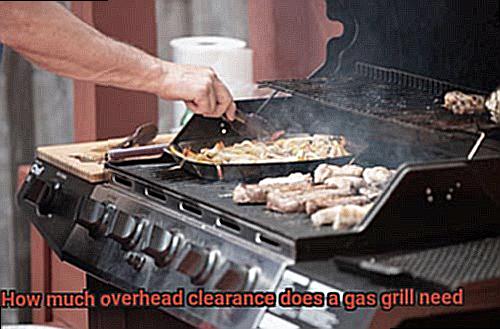
Secondly, the type of fuel you use can also impact the clearance distance. Gas grills that use propane or natural gas produce more heat and flames than charcoal or electric grills. Therefore, they need more overhead clearance to ensure safe operation.
Lastly, the location of your grill plays a critical role in determining the required clearance distance. If your grill is located under an overhang or near combustible materials like wooden fences or shrubbery, it will require more overhead clearance than a grill located in an open space with no surrounding combustible materials.
To ensure maximum safety when setting up your gas grill, always consult the manufacturer’s instructions and local building codes. Don’t take shortcuts or make assumptions; follow the guidelines strictly. Here are some tips to keep in mind:
- Check if your local building codes have specific clearance requirements for gas grills.
- Make sure that your grill is installed on a stable surface and is level.
- Keep your grill at least 10 feet away from any combustible materials.
- Regularly clean your grill to prevent grease buildup and fire hazards.
The Importance of Adequate Overhead Clearance
Summer is here, and it’s time to fire up the grill. However, before you do, it’s crucial to ensure that you have adequate overhead clearance. What is overhead clearance? It’s the space between the top of your grill and any potential obstructions like tree branches, building eaves, or other structures. Why is overhead clearance so important? Let’s explore.
First and foremost, grilling requires heat, which rises. If your grill is too close to an obstruction like a tree branch or building eave, the heat can ignite the obstruction and start a fire. Not only is this a danger to your property, but it’s also a risk to people around the grill. To avoid such a situation, ensure that there is enough space between your grill and any potential obstructions.
In addition to fire hazards, having sufficient overhead clearance allows for proper ventilation and airflow. Grills require ventilation to operate correctly and efficiently. Without proper ventilation, gas grills can produce carbon monoxide gas, which is odorless and colorless and can be deadly if inhaled. Ensuring that there is enough space above your grill allows proper ventilation and reduces the risk of carbon monoxide poisoning.
Lastly, having enough overhead clearance allows for easy access to the grill. When grilling, it’s common to need to open and close the lid frequently. If there isn’t enough space above the grill, this can be difficult or even impossible to do safely.
In summary, ensuring adequate overhead clearance is critical for safe and enjoyable grilling. To make sure that you’re grilling safely this summer, take the time to measure and ensure that there is enough space above your grill. This small step can make all the difference between a safe and enjoyable grilling experience or a hazardous one. Some other tips to keep in mind include:
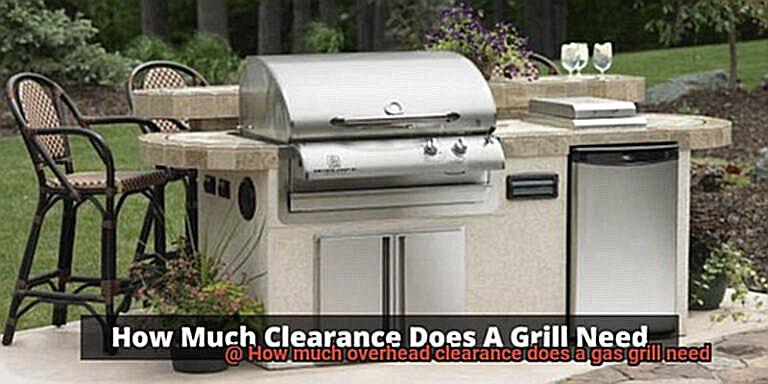
- Keep your grill at least 10 feet away from any structures or trees
- Use a grill cover to protect your grill from the elements and debris
- Always have a fire extinguisher nearby in case of emergencies
How to Determine the Recommended Clearance for Your Grill
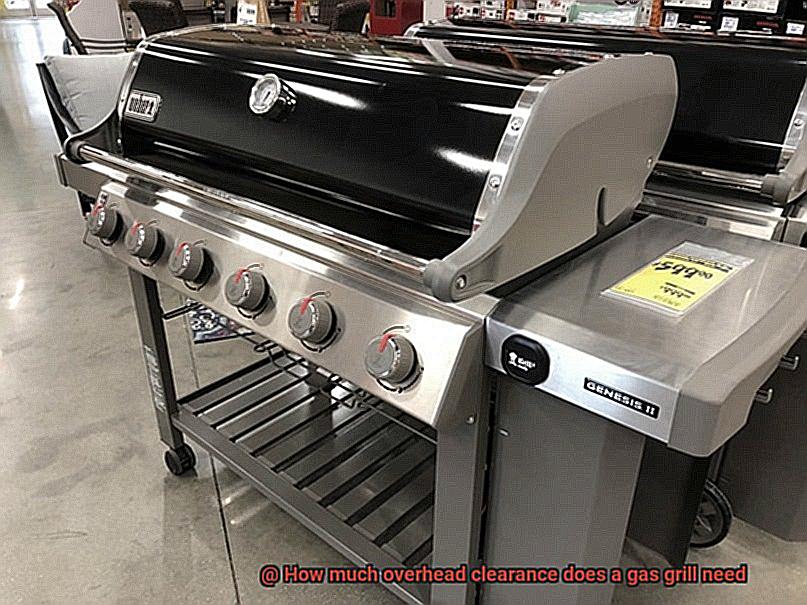
Grilling is an enjoyable activity that brings friends and families together. However, as with any cooking method, safety should always be a top priority. One crucial aspect of grilling safety is determining the recommended overhead clearance for your grill. Let’s take a closer look at how to do just that.
Understanding Overhead Clearance
Overhead clearance refers to the amount of space needed between the top of your grill and any surrounding structures or objects. This distance is important to prevent fires and ensure proper ventilation for your grill.
General Rule of Thumb
A good general rule of thumb is to have at least 2-3 feet of clearance above the grill. This recommendation can vary depending on the type of grill you have and its specific features.
Consult the Owner’s Manual
To determine the specific recommended clearance for your grill, consult the owner’s manual or contact the manufacturer directly. They will have specific guidelines based on your grill’s design and features.
Factors That Impact Clearance
The recommended clearance for your grill can be impacted by various factors such as the size, design, and features of your grill. For example, charcoal grills may require more space due to their higher heat output and potential for flare-ups.
Other Safety Measures
Besides overhead clearance, there are other essential safety measures that you should take into account when setting up your grill. These include proper ventilation and placement away from flammable materials such as trees or bushes. Always keep a fire extinguisher nearby and never leave your grill unattended while in use.
Enjoy Your Grilling Experience Safely
By taking these steps to properly set up your grill and follow recommended safety guidelines, you can enjoy a safe and enjoyable grilling experience with your loved ones.
Tips for Properly Placing Your Grill
Grilling is a beloved pastime for many, but it’s important to remember that safety should always come first. Proper placement of your gas grill is essential to ensure that you can enjoy delicious food without any potential hazards. Here are some key factors to consider when placing your grill:
Overhead clearance is crucial
The National Fire Protection Association recommends at least a 10-foot clearance from any combustible structure or surface, such as a building, tree branches, or awnings. However, consult your user manual for specific guidelines on overhead clearance. Ensure that your grill has enough space above it to prevent fires and other accidents.
Location matters
When selecting a spot for your grill, make sure it’s on a level surface that’s not prone to shifting or tipping. A flat concrete patio or deck is an ideal location. Avoid placing your grill on grass or other uneven surfaces, as this can be hazardous. Additionally, consider the location of your grill in terms of ventilation and wind direction.
Adequate ventilation is necessary
Gas grills require proper airflow to work safely and efficiently. Make sure the grill is not located near any walls or structures that could block airflow and cause dangerous fumes to build up. If you’re placing your grill under a covered patio or awning, ensure there is adequate ventilation to prevent smoke buildup.
Consider prevailing wind direction
Placing your grill downwind from any combustible structures or objects will help prevent flare-ups and reduce the risk of fire. Be aware of the wind patterns in your area and place your grill accordingly.
Follow manufacturer instructions
Always follow the manufacturer’s instructions for safe installation and use of your gas grill. This includes proper assembly, connection to a gas source, and maintenance procedures. By doing so, you can rest assured that you’re grilling safely and efficiently.
Common Mistakes to Avoid when Setting Up Your Gas Grill
Grilling is a summertime staple for many households. It’s a great way to enjoy the outdoors, bond with friends and family, and indulge in some mouth-watering food. However, grilling can also be a dangerous activity if you’re not careful. Therefore, it’s essential to avoid common mistakes when setting up your gas grill.
Here are some tips to ensure a safe and enjoyable grilling experience:
Overhead Clearance
One of the most crucial things to consider when setting up your gas grill is overhead clearance. This refers to the space between the grill and any overhead structures like roofs, awnings, or tree branches. Not leaving enough clearance for your grill is a common mistake that many people make. This can lead to heat damage or even a fire.
To avoid this, be sure to follow the manufacturer’s recommendations for your specific grill’s minimum overhead clearance. Don’t assume that all grills require the same amount of clearance.
Wind Direction
Another mistake that people often overlook is wind direction. Positioning your grill in a way that allows smoke and heat to blow directly into nearby structures like windows or doors can cause damage and create hazardous conditions for those inside.
To avoid this, take note of the wind direction before setting up your grill. Position your grill so that smoke and heat are blowing away from any nearby structures.
Stable Surface
Ensuring that your grill is on a stable and level surface is also crucial for safe grilling. A wobbly or uneven grill may cause food to cook unevenly and pose a danger.
To avoid this, check that your grill is on a solid surface before cooking and use a level to make sure it’s even.
Safety Considerations When Grilling with a Gas Grill
Summer is here, and there’s nothing quite like grilling up some delicious food on a gas grill. However, it’s important to remember that safety should always come first when it comes to grilling. As an expert in this area, I highly recommend taking the necessary precautions to ensure a safe and enjoyable grilling experience.
One crucial safety consideration is the amount of overhead clearance required for your gas grill. Gas grills produce intense heat that can easily ignite combustible materials such as tree branches, awnings, or even your home’s siding. To prevent fires and ensure safe grilling practices, the National Fire Protection Association (NFPA) recommends placing your gas grill at least 10 feet away from any combustible materials. Additionally, make sure there’s a minimum of 24 inches of clearance between the grill and any non-combustible overhead structures like a pergola or roof overhang.
But what if you’re unsure about the clearance requirements or have questions about safe grilling practices? It’s always better to be safe than sorry. Consult the manufacturer’s guidelines or seek advice from a professional.
Another crucial safety consideration is the stability of your grilling surface. Make sure your gas grill is on a level surface to prevent accidents or spills. Also, check for gas leaks by conducting a quick inspection before each use.
It’s also essential never to leave your grill unattended while it’s in use. Keep an eye on your grill at all times, especially if there are children or pets nearby.
In summary, here are some safety considerations to keep in mind when grilling with a gas grill:
- Ensure proper overhead clearance by placing your grill at least 10 feet away from any combustible materials and maintaining 24 inches of clearance between the grill and any non-combustible overhead structures.
- Check for gas leaks by conducting a quick inspection before each use.
- Keep your grill on a level surface to prevent accidents or spills.
- Never leave your grill unattended while it’s in use, especially if there are children or pets nearby.
Conclusion
In conclusion, grilling with a gas grill is an enjoyable experience that requires safety as a top priority. The amount of overhead clearance required for safe operation is one of the most crucial safety considerations. A minimum of 24 inches of clearance between the top of your grill and any overhead structures or objects is recommended by most manufacturers and safety guidelines. However, depending on the size of your grill and any specific safety concerns in your area, you may need more space.
The type of grill, fuel used, and location are factors that affect the required clearance distance. To determine specific recommendations based on your grill’s size and features, consult the owner’s manual or contact the manufacturer directly.
Other essential safety considerations when grilling with a gas grill include proper ventilation, placement away from flammable materials like trees or bushes, using a stable surface such as a level concrete or paver patio, checking for gas leaks before each use, never leaving your grill unattended while in use, and having a fire extinguisher nearby in case of emergencies.
By strictly following these guidelines and taking necessary precautions, you can enjoy a safe and mouth-watering grilling experience with your loved ones this summer.

